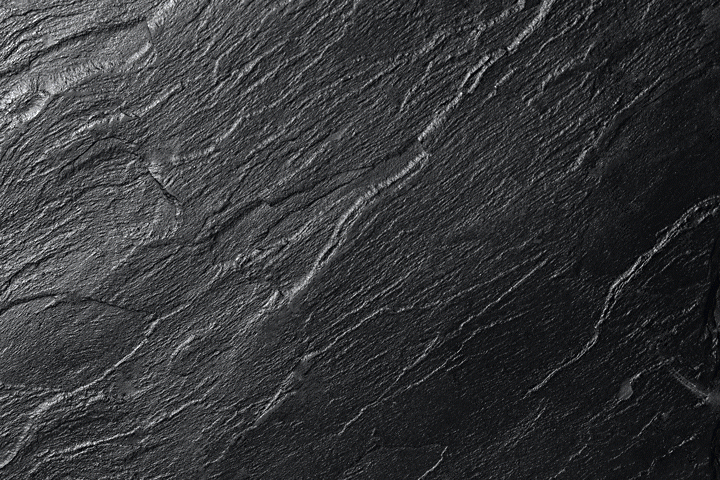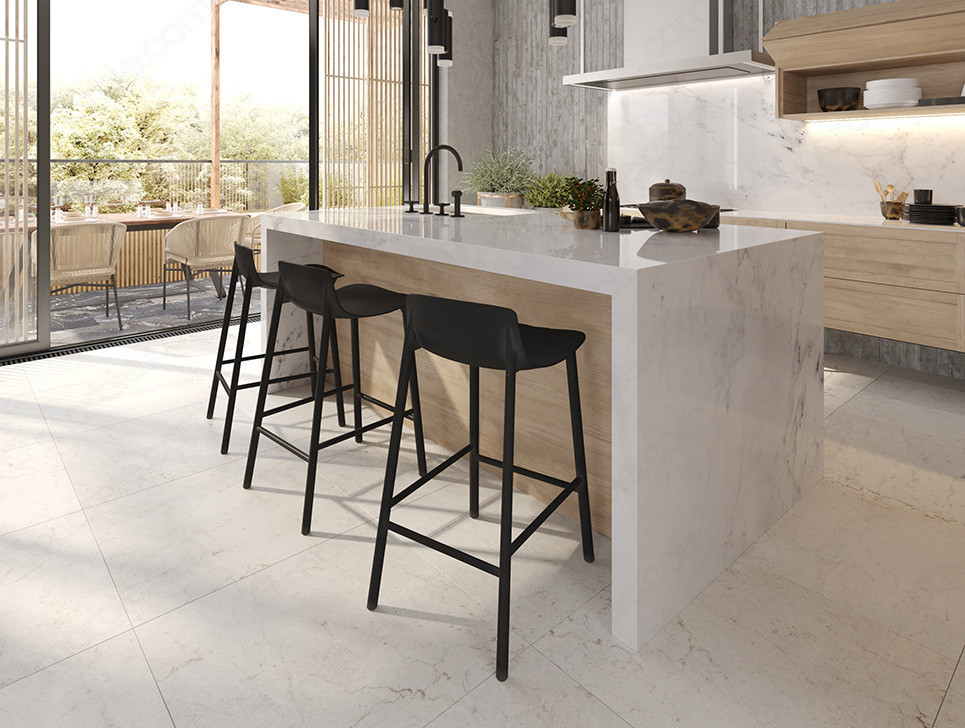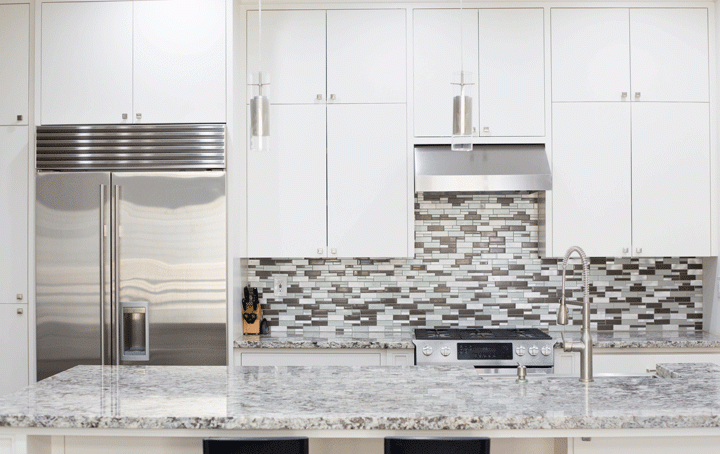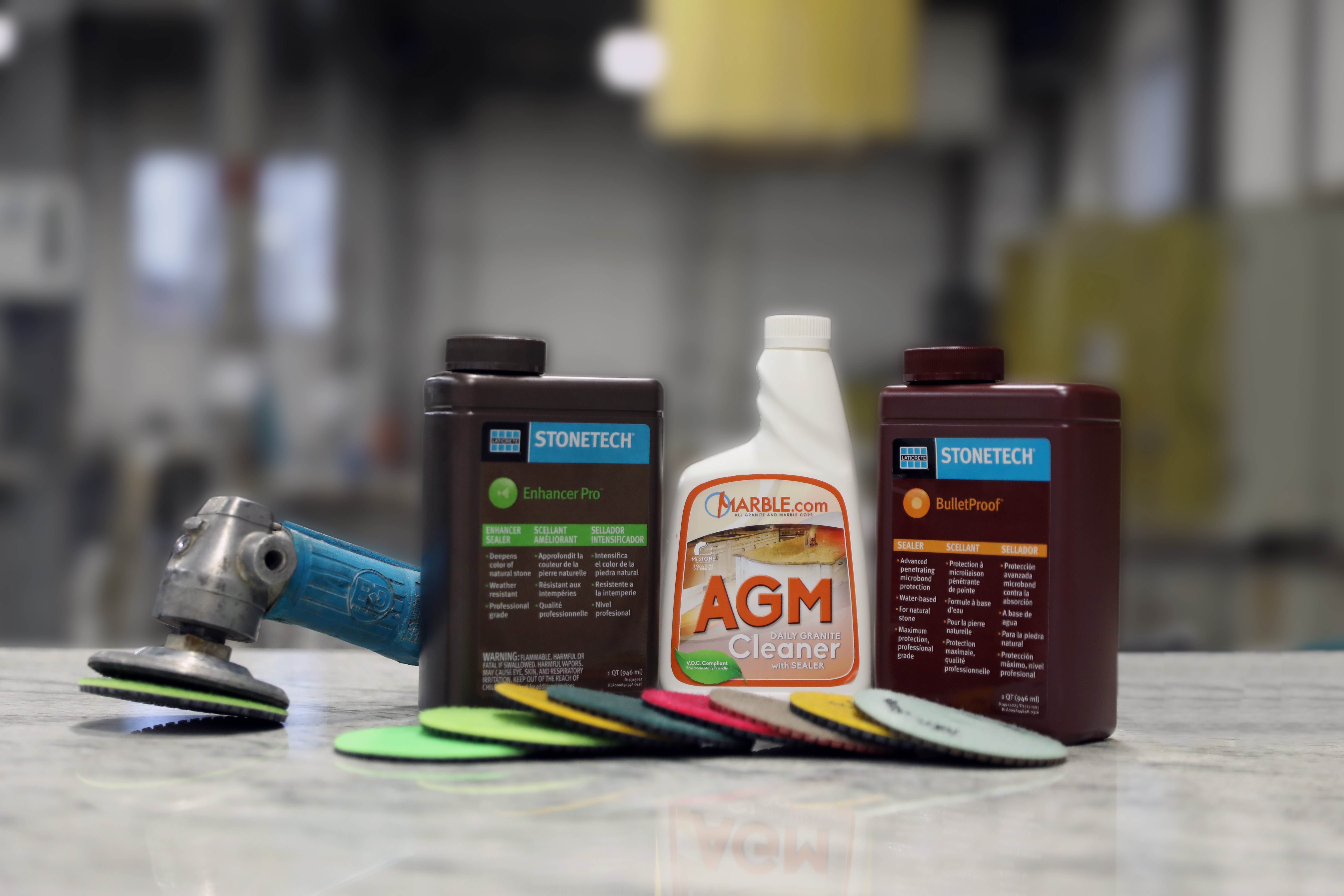
Table of Contents
Granite countertops have become a staple of many homes. The natural stone is beloved by many homeowners for its beautiful looks and durability. Granite can be found in a vast array of colors, which include different patterns of veins, flecks and swirls. Granite countertops are heat and stain resistant, which makes for an ideal surface in the kitchen, bathroom or any other room in the house.
With granite countertops, you will have different options for finishes. Two of the finishes are honed and polished. In fact, these are the two most common that you will see in granite countertops. However, you do have a third option: A leathered finish. Although not as popular as the other two, leathered granite is rising in popularity because of its unique and interesting appearance. This guide will walk you through everything you need to know about leathered granite, from the creation process to the care and maintenance of leathered granite countertops.
[get_quote]
What is Granite?
Granite is a beautiful natural stone that is often used for countertops. The stone has had many uses over thousands of years, including construction of some of the world’s most famous buildings and monuments, such as the Vietnam Veterans Memorial in Washington, D.C. The stone is one of the strongest materials you can use for your countertop. It can also be used elsewhere in the house, including floors, walls and tables. Although certain types can get pricey, granite is one of the less expensive natural stone countertop options.
What is Leathered Granite?
Now that you know more about granite in general, you may be wondering: What exactly is leathered granite? Leathered granite is a finish option for your countertops that will leave the surface with a slightly matte appearance and highlight the natural contours and coloring of the stone. It is among a few options that you will have for countertop finishes, the others being honed and polished.
What Are the Other Finish Options You Can Have?
As mentioned above, leathered is not the only finish option you will have for your granite countertops. You can also choose to have the stone honed or polished. Both of these options are explained in further detail below.
What is Honed Granite?
Honed granite will leave the stone with a beautiful matte look. It is smooth to the touch and gives off a relaxed feel in the room. A honed granite countertop will be as close to the natural look of the stone as you can find. While these surfaces are attractive in their own right, many homeowners find that a downside of honed granite is that the stone lacks the pop of color that you get from a polished finish. Honed granite is also more prone to staining than polished or leathered granite, so keep that in mind when assessing your options. Despite this, it still remains a popular option on the market.
What is Polished Granite?
Polished granite is the most common finish for granite countertops. As its name implies, the stone is polished to produce a distinctive shine that can make your countertop the focal point of any room. Polished granite countertops have many benefits, including stain and heat resistance and less maintenance requirements than honed granite countertops.
How is Granite Leathered?
Leathered granite gets its texture as a result of a diamond tipped brush being run over the surface of the stone, which takes away any imperfections while polishing the slab. The end result can have many different forms; it will depend on how exactly the homeowner wants their granite countertop. Leathering can leave the slab as rough or smooth as the homeowner desires. Any way you choose to have your stone leathered, this complicated process will produce a stunning new countertop surface for your home.
How Can You Properly Care for Your Leathered Granite Countertops?
Proper care of leathered granite countertops is not as much of a hassle as you would encounter with honed or polished granite. Leathered granite can hide any stains that might pop up. On the other hand, honed and polished granite countertops will require a little more care. Although you will have to re-seal your leathered granite countertop, you will have to re-seal honed or polished countertops more often – especially honed.
Advantages and Disadvantages of Leathered Granite Countertops
Leathered granite countertops, as you will find with any countertop, come with advantages and disadvantages. These advantages and disadvantages are listed in the table below and explained in further detail below that.
Leathered Granite Countertops: Advantages
Leathered granite will offer many advantages for your countertop. These advantages include:
| Advantages |
|---|
| Makes Natural Color Stand Out |
| Unique Texture |
| More Customizable Than Other Options |
| Stain Resistant |
Makes Natural Color Stand Out
A major difference between leathered granite and polished is that leathered will bring out the beauty in the natural color of the stone, while a polished finish does the same thing but adds increased shine. For homeowners who prefer the natural look of stone, leathered granite is a great option.
Unique Texture
You will get a unique texture with leathered granite. While honed and polished are more traditional finishes, leathered granite is a surface unlike any other.
More Customizable Than Other Options
One of the major benefits you will get with leathered granite is some customization abilities. You can determine to what extend you want your granite countertop leathered, which can produce a smoother or rougher look depending on what you desire.
[get_quote]
Stain Resistant
Leathered granite is also stain resistant, which makes it a perfect countertop option for the kitchen or bathroom since both rooms see frequent use.
Leathered Granite Countertops: Disadvantages
Leathered granite countertops also have disadvantages, including:
| Disadvantages |
|---|
| Hard to Clean |
| Prone to Scratching |
Hard to Clean
One of the major downsides to leather granite is that the surface is hard to clean. Because it can be more textured than polished or honed granite, dirt and dust can become trapped in grooves. The level of difficulty that you will experience with cleaning is dependent on how textured you want your leathered granite countertop to be. The smoother it is, the easier it will be to clean. Conversely, the more textured it is, the more difficult it will be to keep clean.
Prone to Scratching
Another downside to leathered granite is that it can scratch easier than other finishes. However, if you use a strong sealant and exercise proper levels of caution, this can lessen the problem.
Why Do You Need to Seal Granite?
Now that you know different finishes require more or less frequent sealing, you may be wondering, why is there a need to seal granite countertops anyway? In short, sealing your granite countertop will protect the surface from damages. Granite, like most natural stones, is porous and can be compromised by liquid spills. If you do not seal your granite countertop, you will run the risk of the stone sustaining damages. Granted, granite is not the most porous natural stone, but you should still be as careful as you can be – especially considering that this is such a large investment.
Out of the different finishes available, a granite countertop with a leathered finish is the least likely to be adversely impacted by stains. Although this may be the case, it is still recommended that you seal the countertop.
How Do You Seal a Granite Countertop?
Although the process may sound like an inconvenience, sealing your granite countertop is not difficult at all. The process will take roughly half an hour of your time. Before discussing how to seal the countertop, you must determine if the surface requires sealing.
How Do You Know It is Time to Re-Seal the Countertop?
Different slabs of granite have different sealing requirements. As mentioned above, some need to be re-sealed more frequently than others. If you are looking to determine if your granite countertop needs to be re-sealed, there is a simple test you can do. Start by taking a small amount of water and carefully spill it on a small area of the countertop. If the water absorbs within five to 10 minutes, your granite countertop needs to be re-sealed as soon as possible. On the other hand, if the water beads on the surface, the current seal is still effective.
How Do You Re-Seal a Granite Countertop?
If you have been able to determine that your granite countertop needs to be re-sealed, there are many different sealants on the market for you to choose from. Many of these products come in spray bottles, making the process even easier. In most cases, you will have to apply the sealer to the countertop and wait for 20 to 30 minutes. If you see the sealer has penetrated the surface, apply another coat and repeat the process. After this process, remove the excess sealer with a clean, dry towel and let the countertop sit for 24 hours. For instructions specific to the sealer you are using, make sure to read the label on the back of the product.
What Will Happen If You Do Not Seal a Granite Countertop?
If for some reason you choose not to seal your granite countertop, you are risking the surface incurring liquid damages. As a natural stone, granite is porous, meaning liquids are able to penetrate the surface. If water would sink down into the stone, just imagine what more acidic liquids such as orange juice, coffee and wine could do. While water will evaporate, acidic liquids will not. You will be left with permanent damages to your countertop. It is not a stretch to say that the majority of homeowners would not like having their new countertops ruined, so it is in your best interest to seal the surface. If you do not, you are aware that it is a risk you are taking.
How Do You Clean a Leathered Granite Countertop?
Leathered granite hides smudges and stains easier than granite countertops that are polished or honed. In terms of cleaning, you can use just soap and warm water to clean any granite countertop. For leathered granite specifically, you can use a hand broom to remove crumbs and dust that may become trapped in the grooves. If you keep up with cleaning and sealing your granite countertop, it can look amazing for years to come.
[get_quote]
Where Will a Leathered Granite Countertop Look the Best?
A leathered granite countertop looks particularly stylish in a rustic setting. Between the subdued colors and the rougher texture, a leathered granite countertop can make for an interesting kitchen countertop, vanity top or other surface. Since you are the only person who can truly determine what you define as beautiful, you can install leathered granite wherever you see fit.
Leathered granite continues to rise in popularity, as many homeowners desire to have the attractive and durable material in their homes. No matter if you install it in the kitchen, bathroom or any other room in the house, leathered granite will provide a beautiful natural look that can visually enhance any space. In addition, you will truly be able to get a countertop that you like, as leathered granite can be customized to make it how you want. If you desire a countertop that brings a unique look to your space, leathered granite can do just that.
















 The article helped me immensely
The article helped me immensely
 I’m now more informed on the subject
I’m now more informed on the subject
 I have questions about Marble.com
I have questions about Marble.com
 The article was not accurate at all
The article was not accurate at all
 There is a serious lack of information
There is a serious lack of information
 I have questions about Marble.com
I have questions about Marble.com